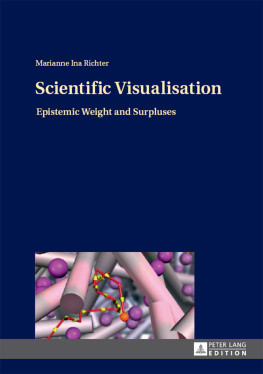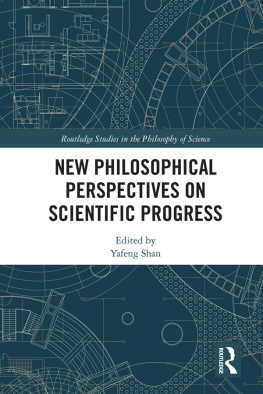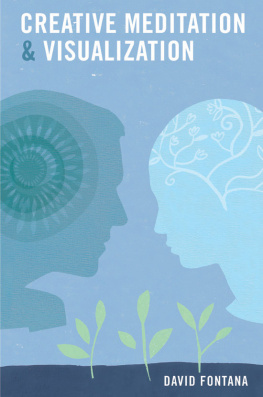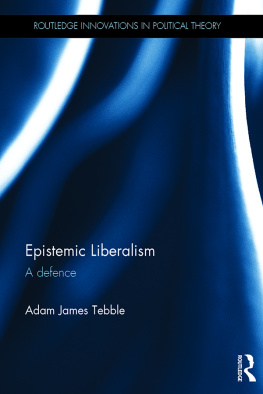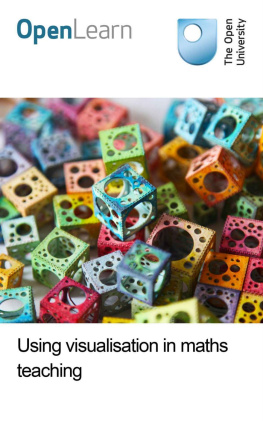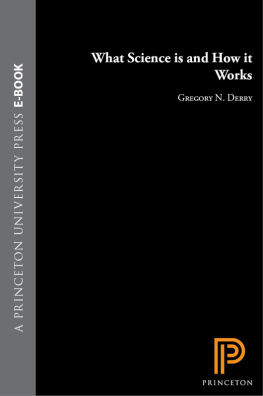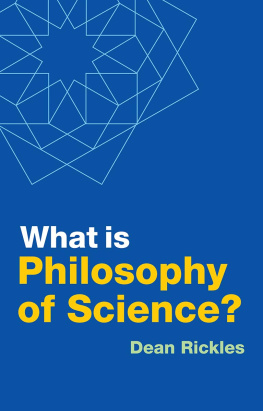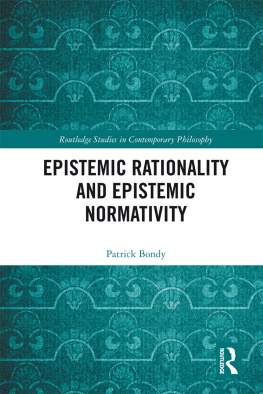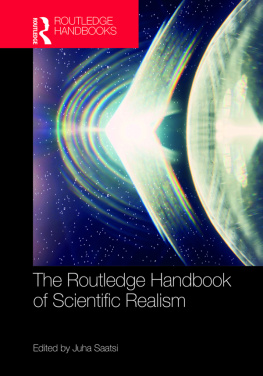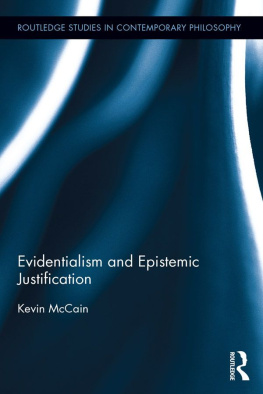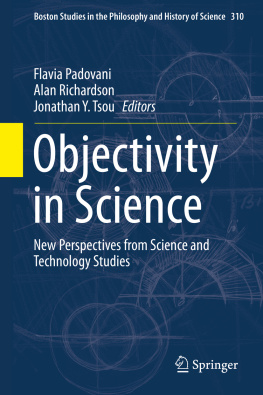Scientific Visualisation
Marianne Ina Richter
Scientific Visualisation
Epistemic Weight and Surpluses

Bibliographic Information published by the Deutsche
Nationalbibliothek
The Deutsche Nationalbibliothek lists this publication in the Deutsche Nationalbibliografie; detailed bibliographic data is available in the internet at http://dnb.d-nb.de.
Zugl.: Stuttgart, Univ., Diss., 2013
Library of Congress Cataloging-in-Publication Data
Richter, Marianne Ina, 1984
Scientific visualisation : epistemic weight and surpluses / Marianne Ina Richter. 1 [edition].
pages cm
ISBN 978-3-631-64300-6
1. ResearchMethodology. 2. Creative thinking. 3. Visualization.
4. ScienceMethodology. I. Title.
Q180.55.M4R53 2014
001.4'2dc23
2013044745
Cover illustration:
Martin Falk
D 93
ISBN 978-3-631-64300-6 (Print)
E-ISBN 978-3-653-03166-9 (E-Book)
DOI 10.3726/ 978-3-653-03166-9
Peter Lang GmbH
Internationaler Verlag der Wissenschaften
Frankfurt am Main 2014
All rights reserved.
Peter Lang Edition is an Imprint of Peter Lang GmbH.
Peter Lang Frankfurt am Main Bern Bruxelles New York Oxford Warszawa Wien
All parts of this publication are protected by copyright. Any utilisation outside the strict limits of the copyright law, without the permission of the publisher, is forbidden and liable to prosecution. This applies in particular to reproductions, translations, microfilming, and storage and processing in electronic retrieval systems.
Dieses Buch erscheint in der Peter Lang Edition und wurde vor Erscheinen peer reviewed.
www.peterlang.com
About the author
The Author
Marianne Richter studied philosophy and literature in Stuttgart, Erlangen (Germany) and London. She received her doctoral degree in philosophy at the University of Stuttgart. Her interests are devoted to issues at the various interfaces between science, philosophy of science, ethics and aesthetics.
About the book
Marianne Ina Richter
Scientific Visualisation
Much of the recent confidence in the future of science and technology stems from advances in scientific visualisation. But is it right to assume that visual and especially pictorial measures carry special epistemic weight in the context of scientific reasoning? Do pictorial approaches have any surpluses, compared to other semiotic types? This book delves into these issues from the point of view of the philosophy of science. New examples from the field of scientific visualisation are introduced in order to account for the epistemic weight and surpluses of syntactically dense pictorial symbol systems.
This eBook can be cited
This edition of the eBook can be cited. To enable this we have marked the start and end of a page. In cases where a word straddles a page break, the marker is placed inside the word at exactly the same position as in the physical book. This means that occasionally a word might be bifurcated by this marker.
8 | 9
| C | Chondrogenic cell (Chondrocyte) |
| DN model | Deductive-Nomological model |
| Dof | Depth of field |
| MAPK | Mitogen-Activated Protein Kinase |
| MAPKp | Mitogen-Activated-phosphorylated Protein Kinase |
| MB | Megabyte |
| MSC | Mesenchymal Stem Cell |
| O | Osteogenic cell (Osteoblast) |
| P | Progenitor cell (Progenitor) |
| PI | Philosophical Investigations |
Wittgenstein (2001) 11953 |
| TLP | Tractatus logico-philosophicus |
Wittgenstein (1974) 11922 |
| TR | Transcriptional Regulator |
| VB | Vertex Buffers |
| xC | Chondrogenic TR |
| xO | Osteogenic TR |
| xP | Progenitor maintenance factor |
| zC | Chondrogenic stimulus |
| zD | Pro-differentiation stimulus |
| zO | Osteogenic stimulus |
| 2D | two-dimensional |
| 3D | three-dimensional 9 | 10 |
10 | 11
11 | 12
Copyrights
2009 IEEE. Fig. 1, Fig, 2, Fig. 19, Fig. 21, Fig. 22, Fig. 23, Fig. 24, Fig. 25, Fig. 26, Fig. 27, Fig. 28, Fig. 29 are reprinted from M. Falk, M. Klann, M. Reuss & Th. Ertl (2009). Visualization of Signal Transduction Processes in the Crowded Environment of the Cell. IEEE Pacific Visualization Symposium (PacificVis 2009), p. 169176. Copyright 2009, IEEE.
2010 AIP Publishing LLC. Fig. 8, Fig. 9, Fig. 10, Fig. 11, Fig. 12, Fig. 14, Fig. 15, Fig. 16, Fig. 17, Fig. 18 are reprinted with permission from D. Schittler, J. Hasenauer, F. Allgwer & S. Waldherr (2010). Cell differentiation modeled via a coupled two-switch regulatory network. CHAOS 20, 045121. Copyright 2010, AIP Publishing LLC.
1957 Allen & Unwin. Taylor & Francis Royalty Department. Fig. 33 is reprinted with permission from C. H. Waddington (1957). The Strategy of the Genes: A Discussion of some Aspects of Theoretical Biology. London: Allen & Unwin, p. 29.
12 | 13 Daniella Schittler. Fig. 13 is published with personal permission.
Martin Falk. Fig. 20 is published with personal permission.
Thomas Ertl. Fig. 32 is published with personal permission.
References to original sources appear with all reprinted material. 13 | 14
14 | 15
16 | 17
The philosophical interest in scientific visualisation had already reached a peak when I started working on this thesis in 2009. Nevertheless, the various contributors to the thriving debates have kept on nurturing diverging intuitions on the nature, exploitability and methodological status of visual and especially pictorial means. It seems that while the prevalence of pictorial means was never called into question their status as aids to the scientist and thus as subjects of interest to the philosophy of science is repeatedly in need of reconsideration. Meanwhile, the range of attributions comprises everything from redundant or distractive to enabling or instructive, which only reinforces the friction between those who think that the image is an extremely rudimentary system [] and those who think that signification cannot exhaust the images ineffable richness (Barthes 1977, p. 32). The implementation of study programs, such as Visual Computing which grew out of computer science, or Visual Studies which involves several disciplines within the humanities, added further fuel to a fire which finally spread to the philosophy of science as well, where it presents a particluar challenge to those who try to analyse the notion of science (and notions related to it) in terms of its integral and contingent components. Following this track, the question arises as to whether the long-neglected pictorial means can be integral to core measures of scientific practice and thus carry epistemic weight in a non-trivial sense.
In my thesis I have also made attempts to use this strategy of conceptualisation. That is, I assume that there are measures, such as representation and argumentation, which are integral to the scientific practices under consideration, and which can be modelled in such a way that we can truly say whether or not a pictorial symbol system has the capacity to become integral to
Next page
